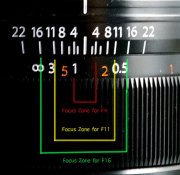rubbernglue
Member
- Joined
- Aug 24, 2013
- Messages
- 177
- Format
- Multi Format
Most cameras I use has a good focus scale so that I can appreciate good focus from a given aperture; and/or perhaps make sure infinity is out of focus, which is often what I want as I set infinity at f/11 while I shoot at f/8 for example.
But I find it hard to select my focusing zone when shooting large format and was wondering what is the best practice for this?
I tried to make my own simple zone-scale on carboard but it was not as simple as I thought as the distance between distance markings cannot be the same for all or something like that.. So imply that I have a 120/5.6 lens for which I want to make a scale, is there a easy way to achive this?
I understand of course that there are apps and various DOF websites for this but I REALLY dont want to fumble around with scaling on a cellphone! I really would like to find a website which can generate a scale in PDF or such for a given lens which I can print and use in the field... At least then I can appreciate distances more easily even if the zone scale is not coupled with the lens.
How do you guys do this and how did people do this before??
But I find it hard to select my focusing zone when shooting large format and was wondering what is the best practice for this?
I tried to make my own simple zone-scale on carboard but it was not as simple as I thought as the distance between distance markings cannot be the same for all or something like that.. So imply that I have a 120/5.6 lens for which I want to make a scale, is there a easy way to achive this?
I understand of course that there are apps and various DOF websites for this but I REALLY dont want to fumble around with scaling on a cellphone! I really would like to find a website which can generate a scale in PDF or such for a given lens which I can print and use in the field... At least then I can appreciate distances more easily even if the zone scale is not coupled with the lens.
How do you guys do this and how did people do this before??











